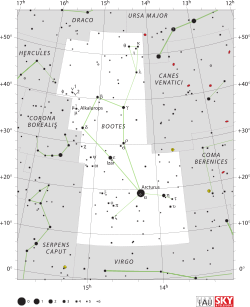| Tau Herculids | |
|---|---|
| Parent body | 73P/Schwassmann–Wachmann |
| Radiant | |
| Constellation | Boötes [1] |
| Right ascension | 13h 56m |
| Declination | +28° |
| Properties | |
| Occurs during | May 19 – June 19 |
| Date of peak | May 31 [1] |
| Velocity | 16 [1] km/s |
| Zenithal hourly rate | variable (Class III) |
The Tau Herculids (TAH #0061) are a meteor shower that when discovered in 1930 appeared to originate from the star Tau Herculis. The parent comet of the Tau Herculids is periodic comet Schwassmann-Wachmann 3 with a 5.4 year orbital period. This meteor shower occurs from May 19 - June 19. The meteor shower was first observed by the Kwasan Observatory in Kyoto, Japan in May 1930. The Tau Herculids' average radiant was α=236°, δ=+41°. [2] Due to orbital perturbations of the meteor streams by Jupiter, 2022 activity will have a radiant of R.A. = 13:56 (209), Decl. = +28 (North-West of the star Arcturus in the constellation Boötes). [1] The meteors are relatively slow moving making atmospheric entry at around 16 km/s (36,000 mph).
On 31 May 1930 the comet passed about 0.062 AU (9.3 million km ; 5.8 million mi ) from Earth, [3] on 9 June 1930 a meteor outburst with a zenithal hourly rate of around 100 was observed, [4] and then the comet passed perihelion (closest approach to the Sun) on 14 June 1930.
On 30–31 May 2022 (31 May 4:00-5:00 UT) there was a modest meteor shower generated by fragments from the 1995 break-up of the parent comet 73P. [5] [6] This required that fragments had been migrating ahead of the comet for the last 27 years. [7] The parent comet has 69 known fragments [8] and does not come to perihelion (0.97 AU from the Sun) until 25 August 2022. [9] On 30 May 2022 comet 73P/Schwassmann–Wachmann was 1.5 AU from the Sun and 1.4 AU (210 million km) from Earth. [10] The next notable appearances of the Tau Herculids are expected in 2033 [6] and 2049. [4]

